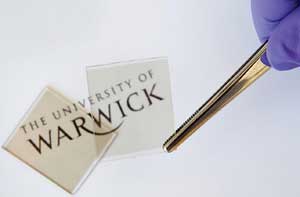A university spinout company wants to put the Midas touch on the organic
solar cell market through the use of gold-coated electrodes. Molecular Solar, the
commercializing force behind the University of Warwick’s endeavors in solar
cell development, believes that gold is the ideal material to replace the traditional
indium tin oxide (ITO) for electrode coating and that it may enable mass production
on flexible substrates.
Currently, ITO-coated glass is the most widely used transparent
electrode for organic solar cells; however, this is largely due to the absence of
a viable alternative.
The problem for organic solar cell applications is that, on the
submicron scale, this complex material is poorly defined, so engineering stable
contacts with the organic semiconductors responsible for harvesting light and transporting
charge is problematic. What’s more, ITO is brittle and, when supported on
flexible plastic substrates, prone to cracking.
Gold, on the other hand, which already is widely used in the electronics
industry, forms reliable interconnects; moreover, it is the material of choice for
electrodes in emerging nanoelectronic and nanophotonic technologies.
“Unlike ITO and other conducting oxides currently used for
transparent electrodes, these ultrathin gold electrodes are chemically well defined
and very smooth,” said Dr. Ross Hatton, who heads up the research on these
novel electrodes as a member of the University of Warwick’s chemistry department.
“Roll-to-roll vacuum evaporation of metal films is also a well-established
process in the packaging industry, making this electrode amenable to mass production.”
These electrodes can be used with a range of solar cell technologies,
but they are particularly well suited to organic solar cells based on small-molecule
semiconductors because both gold and small-molecule organic semiconductors can be
deposited using vacuum evaporation, which presents the tantalizing prospect of fabricating
the entire device without breaking vacuum.
The Warwick group built on previous work by Hatton in which he
used ultrathin gold films as an electrode material for organic LEDs. The drawback
preventing the electrode from progressing, however, was the need for a solvent in
the fabrication process.

Ultrathin gold films on glass may replace traditional ITO electrodes for organic solar cells. Courtesy of the University of Warwick.
Now Hatton and his team have developed a rapid, solvent-free fabrication
process that greatly improves the technological feasibility of these electrodes
and also makes them suitable for use with plastic substrates.
The current high price of gold could give some people pause, but
Hatton explained that, at just 8 nm thick, a sheet of gold costs less than $8 per
square meter. Furthermore, the gold could be recouped at the end of the useful life
of the device, partially offsetting the cost.
For any solar cell technology, efficiencies are the all-important
numbers.
Although the efficiency of organic solar cells fabricated on ultrathin
gold electrodes on glass is 10 to 15 percent lower than that achieved on ITO glass
(due to the difference in transparency), the preliminary work on plastic substrates
is more promising.
Hatton explained that the gold-film electrodes are much more electrically
conductive than ITO electrodes when supported on plastic substrates, and if organic
solar cells are to realize their full commercial potential, they must be produced
on flexible plastic substrates.
While it’s too early to determine the cost per watt, the
Hatton group thinks that if the performance of organic solar cells using a gold
electrode proves to be significantly better than that of cells using other transparent
electrode materials, the gold electrodes may prove economically viable.
The next step for the team is to demonstrate the technology on
flexible plastic substrates, Hatton said. “We are also exploring a number
of approaches to reducing the materials cost, without compromising the advantages
of this transparent electrode.”
This work was supported by the European Regional Development Fund/Advantage
West Midlands SCRA AM2 project, the Engineering and Physical Sciences Research Council
and the Royal Academy of Engineering.